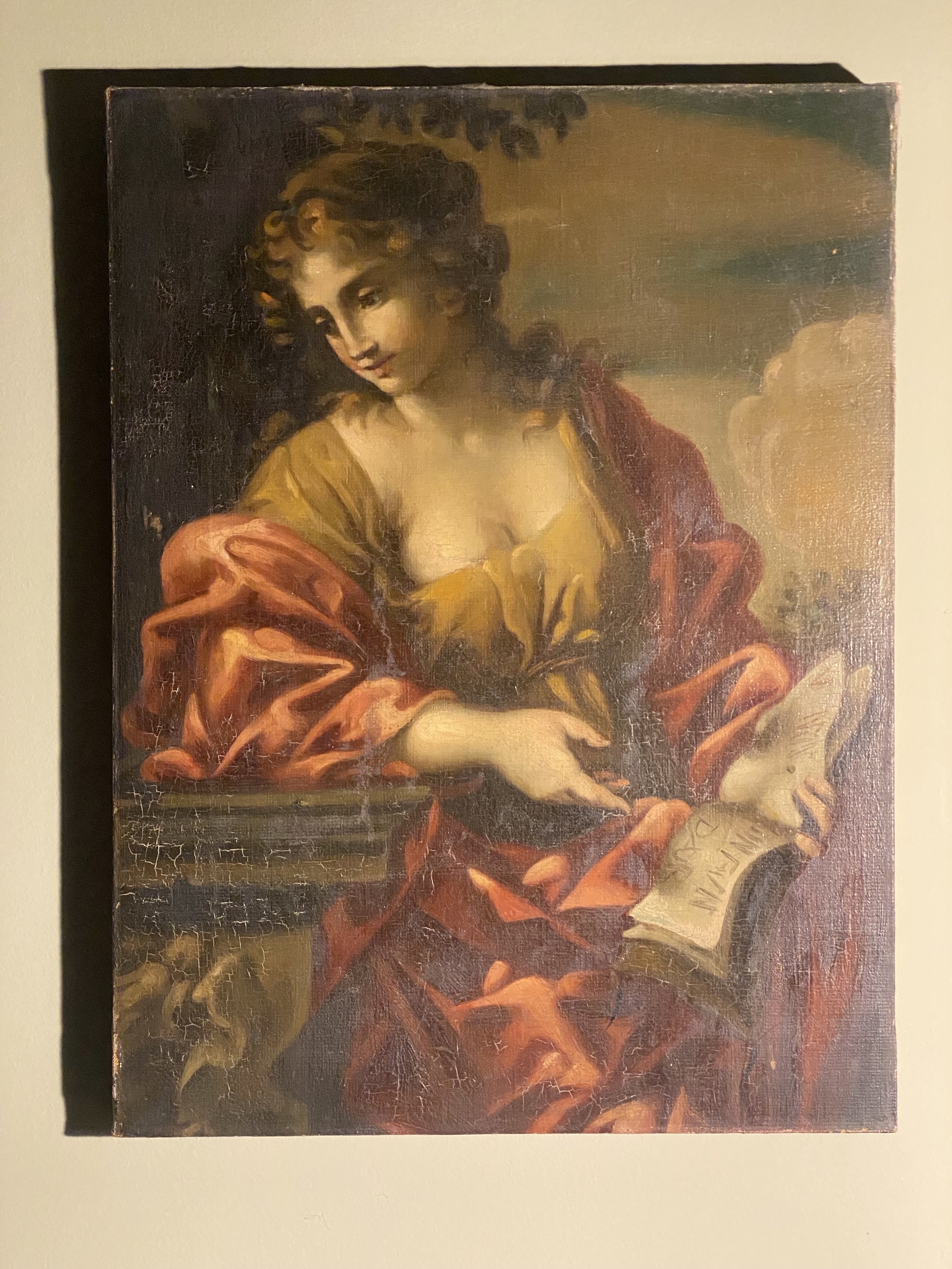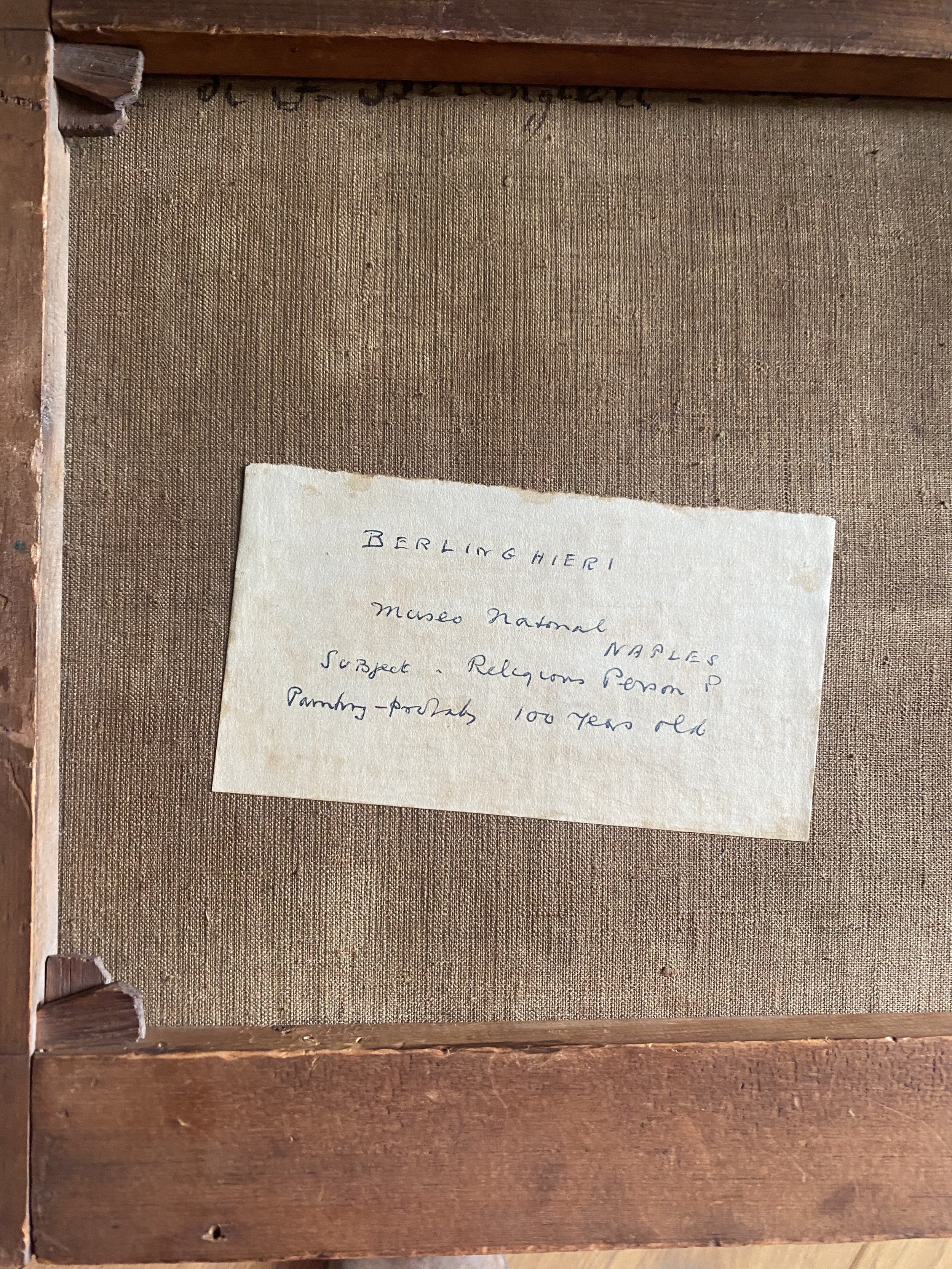 Image 1 of 8
Image 1 of 8

 Image 2 of 8
Image 2 of 8

 Image 3 of 8
Image 3 of 8

 Image 4 of 8
Image 4 of 8

 Image 5 of 8
Image 5 of 8

 Image 6 of 8
Image 6 of 8

 Image 7 of 8
Image 7 of 8

 Image 8 of 8
Image 8 of 8









C19th Oil painting of the Cumaean Sibyl after Giovanni Romanelli, F. Berlingieri.
F. Berlingieri was an Italian 19th Century artist of the 19th century; Oil on canvas, 82x61 cm. After painting by Giovanni Francesco Romanelli from the 17th century, Italian (1610-1662).
The Cumean Sybil; oil on canvas, indistinctly inscribed and dated '1806' on the reverse,
Note: An early 19th-century copy after the original painting by Romanelli, held in the collection of the Galleria Borghese,. The Cumaean Sybil was a historical priestess of the oracle at Cumae, an Ancient Greek colony near Naples, largely known to Romans through her appearance in Virgil’s ‘Aeneid’. Serving as a popular subject amongst 16th-century Italian artists, including Raphael (1483-1520) and in Michelangelo’s (1475-1564) fresco on the ceiling of the Sistine Chapel, Romanelli’s treatment of the subject imparts her with a sense of learned authority, emphasised through the book in her hands, whilst her demeanour expresses a calm composure.
The Cumaean Sibyl was the priestess presiding over the Apollonian oracle at Cumae, a Greek colony located near Naples, Italy. The word sibyl comes (via Latin) from the ancient Greek word sibylla, meaning prophetess. There were many sibyls in different locations throughout the ancient world. Because of the importance of the Cumaean Sibyl in the legends of early Rome as codified in Virgil's Aeneid VI, and because of her proximity to Rome, the Cumaean Sibyl became the most famous among the Romans. The Erythraean Sibyl from modern-day Turkey was famed among Greeks, as was the oldest Hellenic oracle, the Sibyl of Dodona, possibly dating to the second millennium BC according to Herodotus, favored in the east.
The Cumaean Sibyl is one of the four sibyls painted by Raphael at Santa Maria della Pace. She was also painted by Andrea del Castagno (Uffizi Gallery), and in the Sistine Ceiling of Michelangelo her powerful presence overshadows every other sibyl, even her younger and more beautiful sisters, such as the Delphic Sibyl.
There are various names for the Cumaean Sibyl besides the "Herophile" of Pausanias and Lactantius or the Aeneid's "Deiphobe, daughter of Glaucus": "Amaltheia", "Demophile" or "Taraxandra" are all offered in various references.
F. Berlingieri was an Italian 19th Century artist of the 19th century; Oil on canvas, 82x61 cm. After painting by Giovanni Francesco Romanelli from the 17th century, Italian (1610-1662).
The Cumean Sybil; oil on canvas, indistinctly inscribed and dated '1806' on the reverse,
Note: An early 19th-century copy after the original painting by Romanelli, held in the collection of the Galleria Borghese,. The Cumaean Sybil was a historical priestess of the oracle at Cumae, an Ancient Greek colony near Naples, largely known to Romans through her appearance in Virgil’s ‘Aeneid’. Serving as a popular subject amongst 16th-century Italian artists, including Raphael (1483-1520) and in Michelangelo’s (1475-1564) fresco on the ceiling of the Sistine Chapel, Romanelli’s treatment of the subject imparts her with a sense of learned authority, emphasised through the book in her hands, whilst her demeanour expresses a calm composure.
The Cumaean Sibyl was the priestess presiding over the Apollonian oracle at Cumae, a Greek colony located near Naples, Italy. The word sibyl comes (via Latin) from the ancient Greek word sibylla, meaning prophetess. There were many sibyls in different locations throughout the ancient world. Because of the importance of the Cumaean Sibyl in the legends of early Rome as codified in Virgil's Aeneid VI, and because of her proximity to Rome, the Cumaean Sibyl became the most famous among the Romans. The Erythraean Sibyl from modern-day Turkey was famed among Greeks, as was the oldest Hellenic oracle, the Sibyl of Dodona, possibly dating to the second millennium BC according to Herodotus, favored in the east.
The Cumaean Sibyl is one of the four sibyls painted by Raphael at Santa Maria della Pace. She was also painted by Andrea del Castagno (Uffizi Gallery), and in the Sistine Ceiling of Michelangelo her powerful presence overshadows every other sibyl, even her younger and more beautiful sisters, such as the Delphic Sibyl.
There are various names for the Cumaean Sibyl besides the "Herophile" of Pausanias and Lactantius or the Aeneid's "Deiphobe, daughter of Glaucus": "Amaltheia", "Demophile" or "Taraxandra" are all offered in various references.

